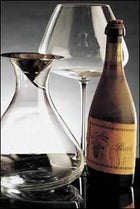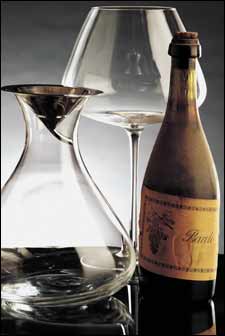The Italians live and breathe great art. The Renaissance genius of Michelangelo. Canaletto's vivid realization of 18th-century Venetian life. And then there are chefs like Marina Ramasso, whose art lasts as long as it takes to swallow—but the memory is as indelible as the exquisite marble lines of David.
A Turin Olympics Glossary
Cinema : Relive the good, the bad, and the ugly of Italian and international cinema at the Museo Nazionale del Cinema. Home to old movie footage, pre-production Chewbacca masks, scripts from classics like Psycho, and a surreal series of display rooms, the museum is housed in Turin’s landmark 548-foot-tall Mole Antonelliana. Ride a hair-raising elevator up to a viewing platform for great views of the city and surrounding mountains. Barolo, Barbaresco, my kingdom for a red!
Barolo, Barbaresco, my kingdom for a red!��
But, please, no more veal. I think I'm about to start bellowing like a tawny calf.
Italians are rightfully proud of their contribution to world cuisine, and nowhere is this legacy better represented than Piedmont and . Think rich, complex red wines, chocolates that have fed the likes of Nietzsche and Grace Kelly, and gnocchi so light that you'd swear they were pillows for Tinkerbell.
But get over your impression that you'll be snarfing down a platter of garlic bread followed by heapings of pasta or pizza. Meals in Piedmont are slow, multi-layered affairs lubricated with wine, espresso, and conversation that flow as long as the lights stay on.
We arrive at the rustic Osteria del Paluch in the Baldissero Torinese, the hills that slope up from the eastern bank of Turin's Po River, to be greeted with a broad table groaning under the weight of wine glasses, candlesticks, and a fruit-filled centerpiece. The Osteria is run by the husband-and-wife team of Marina Ramasso and Lino Bellesse, with their daughters doing the legwork as the wait staff.
Sparkling wine and canapés are followed by a first course of garlic-loaded bagna cauda, a rich local sauce drizzled over the freshest winter cold cuts. At this point, we're merely entranced, eagerly anticipating the next step in an Italian culinary master class.
Round two brings a hearty chick-pea soup, with fresh ingredients swimming in a broth that repels the wintery mix outside. Chef Ramasso picks all the ingredients for each night's menu herself in the markets around Turin, a luxury that we only wish we could enjoy in our speed-obsessed cultures back home. In fact, Piedmont is the home to the Slow Food movement, an international organization of 83,000 members dedicated to offering something more than mass-produced fast-food schlop. Honestly, it all gets a little sanctimonious at points, but I can see the attraction as I swill a second glass of Barolo and realize we're still only on the starters. Bring it on—slowly.
A third course in the Piedmontese marathon of degustation is typically a pasta dish or a wild-rice risotto. I'm ashamed to admit I can't remember what the Osteria brought forth, my note-taking having been hijacked by an inexplicable black hole of booze and banter. However, I can report other highlights from my time eating my way through Turin and Piedmont included delicious stuffed agnolotti de pline (like little ravioli, but better) and buckwheat pasta in a smooth avocado sauce.
Then came the cow. And quite a bit of it.
Apparently, if there's one thing the Piedmontese love to serve their guests, it's veal. And sure, this stuff tastes good when topped with a creamy peppercorn gravy and accompanied by a nice side of roast potatoes. But I'm afraid my time in Turin meant more than a few slices of veal; probably more like a haunch or maybe even an entire flank.
Not to mention the testicles.
Hats off to Chef Ramasso at Osteria del Paluch. Those balls sure did taste good, just one edible in a procession of delicately fried meats and veggies that kept arriving on my plate. Chicken, artichokes, deep-fried cow testicles… In fact, I'd recommend them to anyone, washed down with a fine Barbaresco or Barolo right from the vineyards in the Langhe-Roero region south of town.
By the final stage of pretty much every meal I engorged, my mind had strayed from wine and pasta to the need to refuel with espresso. Call me a glutton, but dessert and coffee are pretty much compulsory when you're in a place that has been making chocolates since the mid-1700s. And we're not talking Nutella here. Creamy little gianduia chocs or fruit-filled tarts soaked in red wine are enough to make a grown man cry for mercy (or a final glass of red). Talk about la dolce vida.
Three hours later we roll out of Osteria del Paluch and I'm calculating how many Olive Gardens you'd need to even get close to Marina Ramasso's mastery of the dark arts of la cucina. I'm still trying to figure it out.


